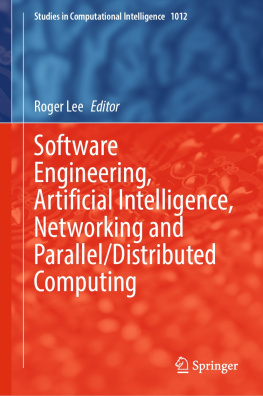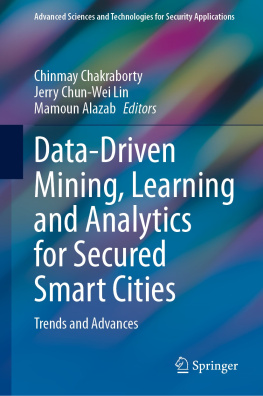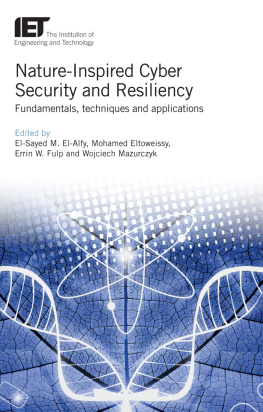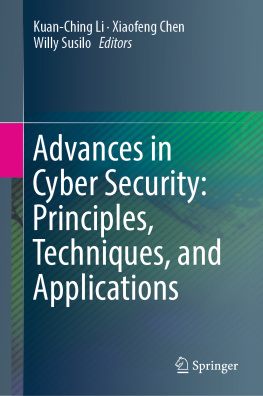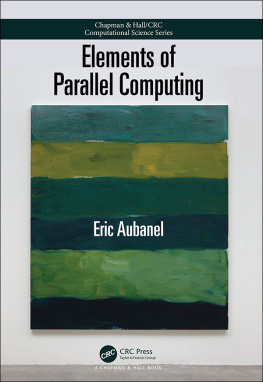
Scrivener Publishing
100 Cummings Center, Suite 541J
Beverly, MA 01915-6106
Publishers at Scrivener
Martin Scrivener ()
Phillip Carmical ()
Managing Editors: Sachin Mishra, S. Patra and Anshuman Mishra
Cyber Security in Parallel and Distributed Computing
Concepts, Techniques, Applications and Case Studies
Edited by
DacNhuong Le
Haiphong University, Haiphong, Vietnam
Raghvendra Kumar
LNCT College, India
Brojo Kishore Mishra
C. V. Raman College of Engineering, Bhubaneswar, India
Manju Khari
Ambedkar Institute of Advance Communication Technologies & Research, India
Jyotir Moy Chatterjee
Asia Pacific University of Technology & Innovation, Kathmandu, Nepal
This edition first published 2019 by John Wiley & Sons, Inc., 111 River Street, Hoboken, NJ 07030, USA and Scrivener Publishing LLC, 100 Cummings Center, Suite 541J, Beverly, MA 01915, USA
2019 Scrivener Publishing LLC
For more information about Scrivener publications please visit www.scrivenerpublishing.com.
All rights reserved. No part of this publication may be reproduced, stored in a retrieval system, or transmitted, in any form or by any means, electronic, mechanical, photocopying, recording, or otherwise, except as permitted by law. Advice on how to obtain permission to reuse material from this title is available at http://www.wiley.com/go/permissions.
Wiley Global Headquarters
111 River Street, Hoboken, NJ 07030, USA
For details of our global editorial offices, customer services, and more information about Wiley products visit us at www.wiley.com.
Limit of Liability/Disclaimer of Warranty
While the publisher and authors have used their best efforts in preparing this work, they make no representations or warranties with respect to the accuracy or completeness of the contents of this work and specifically disclaim all warranties, including without limitation any implied warranties of merchantability or fitness for a particular purpose. No warranty may be created or extended by sales representatives, written sales materials, or promotional statements for this work. The fact that an organization, website, or product is referred to in this work as a citation and/or potential source of further information does not mean that the publisher and authors endorse the information or services the organization, website, or product may provide or recommendations it may make. This work is sold with the understanding that the publisher is not engaged in rendering professional services. The advice and strategies contained herein may not be suitable for your situation. You should consult with a specialist where appropriate. Neither the publisher nor authors shall be liable for any loss of profit or any other commercial damages, including but not limited to special, incidental, consequential, or other damages. Further, readers should be aware that websites listed in this work may have changed or disappeared between when this work was written and when it is read.
Library of Congress Cataloging-in-Publication Data
ISBN 978-1-119-48805-7
To our parents
List of Figures
List of Tables
Foreword
With the widespread applicability of cyberspace in todays world, malefic activities like hacking, cracking or other malicious use of cyberspace have become more sophisticated and so critical that, absent a proper and organized plan to protect against such activities, overcoming them is impossible.
Today cybersecurity is one of the prime concerns for any organization, whether governmental or private sector; and for the sake of security and safety, it may be considered of national importance for a country. Many components of cyberspace are disreputable and therefore vulnerable to an expanding range of attacks by a spectrum of hackers, criminals, terrorists, and state actors. For example, both government agencies as well as private sector companies, irrespective of their size and nature, may suffer from cyber thefts, cyber vandalism and attacks like denial-of-service or other service-related attacks, since they incorporate sensitive information. Many of a nations critical infrastructures, like the electric power grid, air traffic control system, financial systems, and communication networks, depend extensively on information technology for their operation. Nowadays, threats posed by the vulnerabilities of information technology and its malicious use have increased along with technological advancements. Following the infamous September 11, 2001 attacks against the United States, the importance of maintaining a properly fashioned security environment has been realized in light of increased cyber espionage directed at private companies and government agencies. National policy makers have become increasingly concerned that adversaries backed by considerable resources will attempt to exploit cyber vulnerabilities in the critical infrastructure, thereby inflicting substantial harm on a nation.
Numerous policy proposals have been suggested in the past and a number of bills have been introduced to tackle the challenges of cybersecurity. Although the larger public discourse sometimes treats the topic of cybersecurity as a new one, the Computer Science and Telecommunications Board (CSTB) of the National Research Council has extensively recognized cybersecurity as being a major challenge for public policy. Therefore, for over more than two decades the CSTB has offered a wealth of information on practical measures, technical and nontechnical challenges, as well as potential policy concerning cybersecurity. Drawing on past insights developed in the body of work of the CSTB, a committee has produced a report entitled Cybersecurity Primer: Leveraging Two Decades of National Academies Work, which acts as a concise primer on the fundamentals of cybersecurity and the nexus between cybersecurity and public policy.
Full Professor Valentina E. Balas
Department of Automatics and Applied Software Aurel Vlaicu University of Arad, Romania
Preface
The main objective of this book is to explore the concept of cybersecurity in parallel and distributed computing along with recent research developments in the field. Also included are various real-time/offline applications and case studies in the fields of engineering and computer science and the modern tools and technologies used. Information concerning various topics relating to cybersecurity technologies is organized within the sixteen chapters of this book.
Chapter 1 discusses the difference between traditional and contemporary computer crimes observed over the last few years. The general evolution of cybercrimes has led to internet-based risks affecting businesses, organizations, etc., exposing them to potential liability. The recent concept of cyber insurance, which promises coverage when organizations suffer as a result of internet-based risk, is discussed in this chapter. Later on in the chapter, readers will become familiarized with security policies and various security models, such as the Bell-LaPadula and Biba models, that enforce them. Furthermore, readers will also become acquainted with the concepts of network neutrality and human rights, as they go hand in hand. With the risks and aftereffects of cybercrimes in mind, we also explore the legal aspect of cybercrimes by analyzing the concept of computer forensics. Some best practices pertaining to countermeasures to information warfare are also discussed.
Next page



